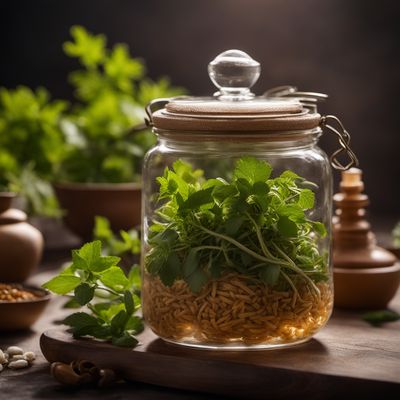
Ingredient
Roots used for herbal infusions
Nature's Healing Brew: Exploring the Power of Herbal Roots
Herbal roots, such as ginger, turmeric, and licorice, are prized for their unique characteristics. They possess a firm texture and earthy appearance, often featuring a rough exterior and a vibrant interior. These roots offer a range of flavors, from spicy and pungent to sweet and woody, and their taste can vary depending on the specific root. With their robust flavors and distinct textures, herbal roots add depth and complexity to herbal infusions.
Origins and history
The use of roots in herbal infusions dates back centuries and is deeply rooted in various cultures around the world. Ginger, for example, has been used in traditional Chinese medicine for over 2,000 years, prized for its warming properties and ability to aid digestion. Turmeric, a staple in Ayurvedic medicine, has a rich history in Indian culture and is renowned for its anti-inflammatory properties. Licorice root, on the other hand, has been used in traditional European medicine for its soothing and expectorant qualities. These roots have been passed down through generations, with their healing properties celebrated across different civilizations.
Nutritional information
Herbal roots are packed with essential nutrients and bioactive compounds. They are often rich in antioxidants, vitamins, and minerals, providing a natural boost to the immune system. While the nutritional content may vary depending on the specific root, they are generally low in calories and fat, making them a healthy addition to any diet.
Allergens
Some individuals may have allergies or sensitivities to certain herbal roots, such as ginger or licorice. It is important to exercise caution and consult with a healthcare professional if you have any known allergies or medical conditions.
How to select
When selecting herbal roots for herbal infusions, look for roots that are firm, free from mold or blemishes, and have a strong aroma. Avoid roots that are soft or shriveled, as they may indicate spoilage. Additionally, choose organic roots whenever possible to ensure they are free from pesticides or other harmful chemicals.
Storage recommendations
To maintain the freshness and quality of herbal roots, store them in a cool, dry place away from direct sunlight. You can wrap them in a paper towel or store them in a breathable bag to prevent moisture buildup. Properly stored, most herbal roots can last for several weeks.
How to produce
Amateur gardeners can grow certain herbal roots, such as ginger or turmeric, by planting root cuttings in well-draining soil and providing them with ample sunlight and water. However, it is important to note that some herbal roots, like licorice, require specific growing conditions and may be more challenging to cultivate at home.
Preparation tips
Before using herbal roots in herbal infusions, wash them thoroughly to remove any dirt or debris. Depending on the recipe, you may need to peel or grate the roots. To extract the flavors and medicinal properties, steep the roots in hot water for a recommended duration, typically 10-15 minutes. Adjust the quantity of roots based on personal preference and desired intensity of flavor. Experiment with different combinations of herbal roots to create unique and personalized herbal infusions.
Culinary uses
Herbal roots are primarily used in herbal infusions, also known as herbal teas. They can be combined with other herbs, spices, or fruits to create a wide range of flavors and health benefits. Additionally, herbal roots are often used in traditional medicine practices, such as Ayurveda or Traditional Chinese Medicine, to address specific health concerns.
Availability
Herbal roots used for herbal infusions are commonly available in various regions around the world. However, the specific availability may vary depending on the root and the local agricultural practices.



